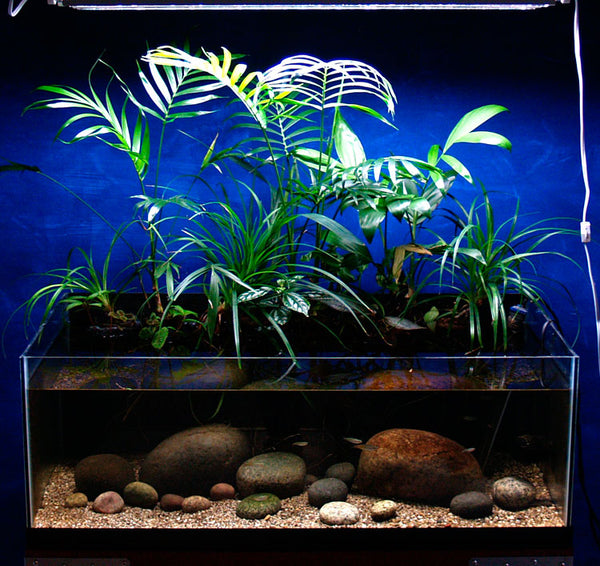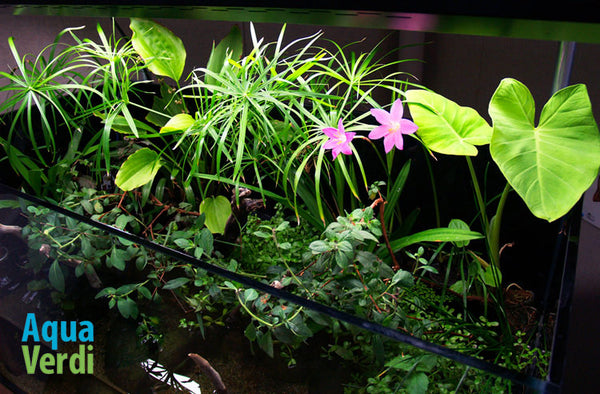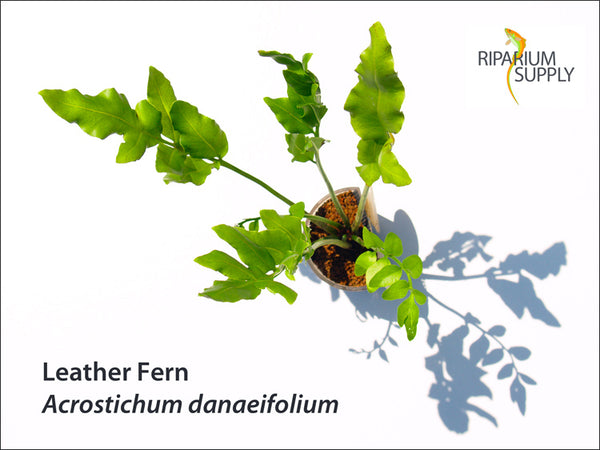We are quickly approaching the long, grey, cold winter months and the best time of year for new aquascaping projects. As you start planning your new layouts, consider trying a planted riparium.

Above, riparium layout in a 40-gallon tank.
Ripariums are a special kind of planted tank featuring marginal aquatic plants; species adapted to grow their roots in very wet soil or in the mud under shallow water, but with most of their foliage in the air. Some very popular aquarium selections, such as Cryptocoryne, Echinodorus, Anubias and many stem plants can grow as marginals with emersed-adapted foliage growing above water, although for aquariums these are usually grown in their immersed (underwater) forms.
Ripariums are further distinguished from another special kind of planted model ecosystem, the paludarium. While they look superficially similar, paludariums use a built-up hardscape to support the planting, whereas ripariums use planter cups positioned on the aquarium glass. Furthermore, the paludarium hardscape is intended to function as part of the visual design, while the riparium planters are hidden from view as the plants grow in.
The following lists the most appealing features of planted ripariums as living displays:
- No extra CO2 required - carbon dioxide gas, essential for plant growth, is many times more available in the air than underwater. Plants in traditional aquascapes are usually limited more be the availability of CO2 than any other factor, so serious aquascapers install CO2 injection systems with pressurized tanks, regulators and diffusers. While CO2 systems can be fun to set up and run, they also represent extra expense and maintenance demands. Riparium plants easily get all of the carbon dioxide they need from the air, so they do not need extra CO2 for vigorous growth.
- Biotope representation - some of the most beautiful wild aquatic ecosystems have few fully submerged underwater plants. Among these are blackwater swamps, mangrove swamps, mountain streams and others with underwater conditions that are tough for plants. These habitats are home to many of the most appealing aquarium fishes, while also hosting distinctive marginal aquatic plant species. A planted riparium is the best way to represent this kind of area with an aquascape biotope.
- Robust plant-based filtration - riparium plants, not limited by availability of dissolved CO2 or algae growth, can grow quickly with new foliage and roots. As they accumulate biomass, the riparium plants will also remove fish waste products (especially phosphate and nitrates) and other pollutants.
- Beautiful blooms and foliage - having evolved in the special marginal aquatic habitat, the best choices for planted ripariums have distinctive shapes, colors and growth habits. If provided with the right nutrition and lighting, a number of the best riparium selections, such as Ruellia, Spathiphyllum, Hymenocallis and Zephyranthes, will also bloom readily with lovely flowers. The planted riparium genre is relatively new in the aquarium hobby and there are still many new plants to be discovered and trialed as riparium choices.
Thank you for reading! We hope that you can also enjoy creative challenges and new discoveries with planning and building a new riparium aquascape.

Above, 120-gallon Mexico river riparium biotope.

Above, Planting Zephyranthes Rain Lily in Aqua Verdi Riparium Planter.

Above, the lovely white bloom of Zephyranthes Rain Lily in a planted riparium.

Above, a Borneo blackwater swamp riparium biotope.

Above, Acrostichum Leather Fern in a riparium planter.
No extra CO2 Required!...And Other Reasons for a Planted Riparium as Your Next Aquascape.
We are quickly approaching the long, grey, cold winter months and the best time of year for new aquascaping projects. As you start planning your new layouts, consider trying a planted riparium.
Above, riparium layout in a 40-gallon tank.
Ripariums are a special kind of planted tank featuring marginal aquatic plants; species adapted to grow their roots in very wet soil or in the mud under shallow water, but with most of their foliage in the air. Some very popular aquarium selections, such as Cryptocoryne, Echinodorus, Anubias and many stem plants can grow as marginals with emersed-adapted foliage growing above water, although for aquariums these are usually grown in their immersed (underwater) forms.
Ripariums are further distinguished from another special kind of planted model ecosystem, the paludarium. While they look superficially similar, paludariums use a built-up hardscape to support the planting, whereas ripariums use planter cups positioned on the aquarium glass. Furthermore, the paludarium hardscape is intended to function as part of the visual design, while the riparium planters are hidden from view as the plants grow in.
The following lists the most appealing features of planted ripariums as living displays:
Thank you for reading! We hope that you can also enjoy creative challenges and new discoveries with planning and building a new riparium aquascape.
Above, 120-gallon Mexico river riparium biotope.
Above, Planting Zephyranthes Rain Lily in Aqua Verdi Riparium Planter.
Above, the lovely white bloom of Zephyranthes Rain Lily in a planted riparium.
Above, a Borneo blackwater swamp riparium biotope.
Above, Acrostichum Leather Fern in a riparium planter.